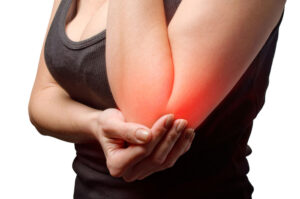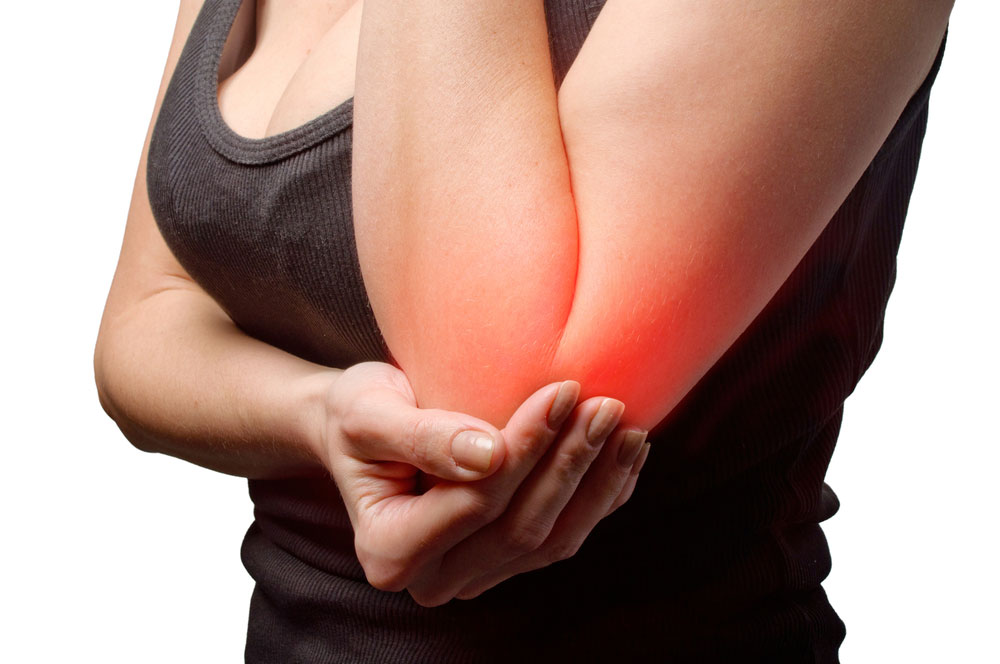Although the elbow is small, it’s a complex joint with cartilage, ligaments, fluid, muscles, tendons, and bone. It helps you with many different movements in your arm and hand, including rotation, extension, and flexing, often combining these motions at one time. Because of this, it can sometimes be hard to pinpoint what type of elbow movement leads to pain and when this pain is a sign of a serious injury calling for a trip to the doctor. Let’s take a look at some signs and types of an elbow injury, so you know how you can manage elbow pain at home and when you need professional help. types of an elbow injury, so you know how you can manage elbow pain at home and when you need professional help.
Signs and Symptoms of Elbow Injury
 Unlike other joints, elbow injuries are not commonly due to arthritis or other wear-and-tear causes. Many times, elbow pain is caused by activities using repetitive motion in the arm, hand or wrist, including in sports, hobbies, or work. Injuries caused by this type of repetitive use are often called overuse injuries.
Unlike other joints, elbow injuries are not commonly due to arthritis or other wear-and-tear causes. Many times, elbow pain is caused by activities using repetitive motion in the arm, hand or wrist, including in sports, hobbies, or work. Injuries caused by this type of repetitive use are often called overuse injuries.
Signs of an elbow injury may include the following:
- Pain during, or right after, using the elbow in an activity such as throwing;
- Decreased mobility or strength in the elbow and arm;
- Elbow stiffness;
- Pain while making a fist;
- Visible deformity;
- Numbness or tingling in the elbow, arm, wrist or hands.
Elbow Injuries and Causes of Elbow Pain
Elbow injuries can be caused by overuse, trauma or, less commonly, wear and tear. Below are some common elbow injuries and causes of elbow pain.
- Arm or elbow fracture: a broken bone in the arm or elbow can cause considerable pain, even visible deformity.
- Elbow dislocation: when the forearm and upper arm bones become out of place with each other, the elbow joint is dislocated.
- Elbow sprain: a torn or stretched elbow ligament injury.
- Tendonitis: inflammation of tendons and connective tissue in the elbow.
- Bursitis: inflammation of the elbow joint.
- Ulnar Collateral Ligament (UCL) Injury (Tommy John Injury): frayed, torn, or loose elbow ligament due to overuse. Check out this story about Weiss orthopedic surgeon Dr. Preston Wolin’s effort to reduce this common injury in young athletes.
- Flexor tendonitis (golfer’s elbow): a painful condition in which tendons in the forearm become attached to a bone on the inside of the elbow.
- Lateral epicondylitis (tennis elbow): inflammation of the tendons linking the muscles of the forearm to the elbow.
- Valgus Extension Overload (thrower’s arm): overuse injury leading to abnormal cartilage deterioration and bone spurs.
- Osteoarthritis: more common in weight-bearing joints, such as the knees and hips, this is when the cartilage of the elbow is damaged or worn out.
- Rheumatoid arthritis: chronic inflammation of the elbow joint.
- Osteochondritis dissecans: less common in adults than in children, it’s caused by a lack of blood supply, leading to parts of bone separating, cracking, or loosening in a joint.
- Nerve entrapment (pinched or trapped nerve): a condition in which bones, tendons, muscles, or cartilage place too much pressure on a nerve in the elbow.
- Ulnar Neuritis (cubital tunnel syndrome): a condition where there is too much pressure in the ulnar nerve near the elbow.
How to Manage an Elbow Injury at Home
Most often, elbow pain is not serious enough to call for a trip to the hospital. Oftentimes, elbow pain can be managed at home. If you are treating your elbow injury at home, first make sure your elbow is protected from further injury. Then, use RICE, a very common method for treating minor sports injuries at home. RICE involves:
REST: Make sure to stop doing the sport or activity that led to the injury
ICE: Three times a day, ice the injured area for 20 minutes.
COMPRESSION: Wrap the injury or use a compression bandage to ease swelling of the injured elbow.
ELEVATION: Elevation will help reduce swelling as well; keep the elbow elevated, when possible, throughout the day.
When to Contact a Doctor for an Elbow Injury
 Although elbow pain is often something that can be managed at home and will improve over time, sometimes elbow pain requires a visit to the doctor..
Although elbow pain is often something that can be managed at home and will improve over time, sometimes elbow pain requires a visit to the doctor..
You should always seek emergency care right away if there is a bone protruding from the skin or an obvious deformity in the elbow.
The below symptoms could be signs of a more serious elbow injury and it’s a good idea to contact a doctor also if any of the following apply:
- The pain is severe or continues to occur even when you aren’t using your arm.
- You have swelling around the elbow joint.
- There is redness or bruising around the elbow that doesn’t go away.
- You have limited mobility in the elbow or forearm.
- If you have been trying to manage the injury at home using RICE and you’re not getting any improvement in the pain or other symptoms.
Treatment Options at Weiss for Elbow Pain
The Chicago Center for Orthopedics (CCO) at Weiss has orthopedic specialists covering every bone and joint, including experts in elbow, arm, and hand injuries.
Treatment for elbow pain will depend on the individual and the injury, but seeking help for elbow pain doesn’t have to be intimidating. Treatment for an elbow injury may include physical therapy, bracing, injections, or surgical options. Your CCO physician will prescribe a treatment plan that is tailored to your needs.
For an appointment with a specialist to help you with your elbow pain, call 773-564-7770 today.

